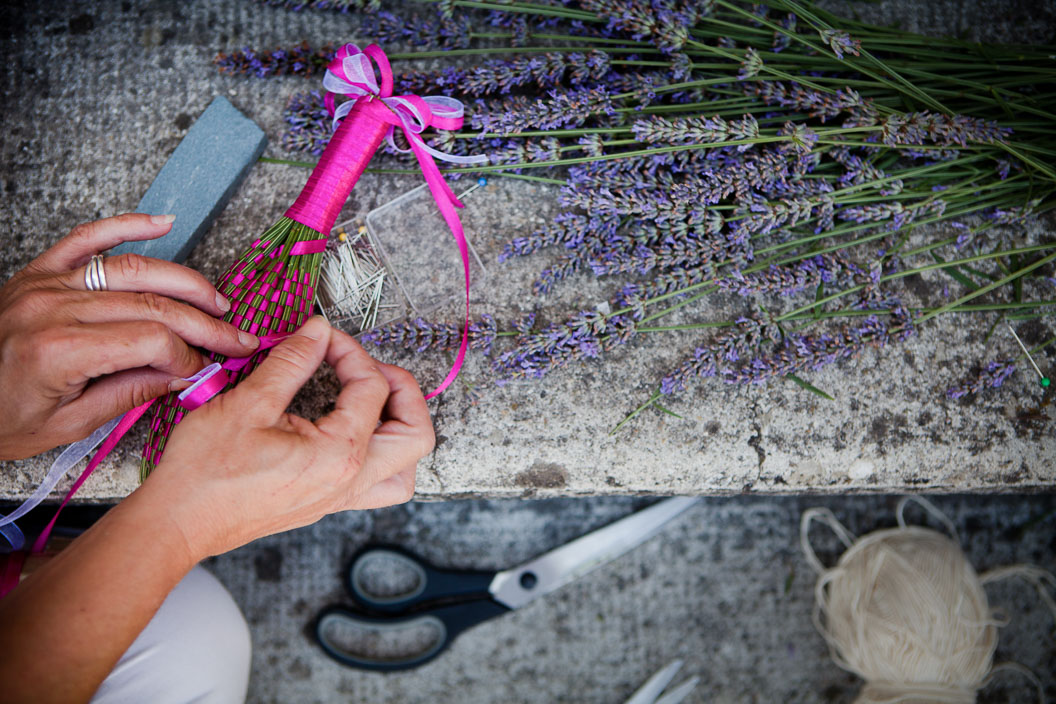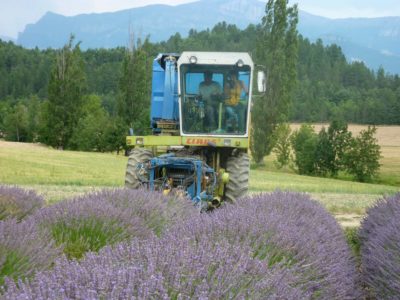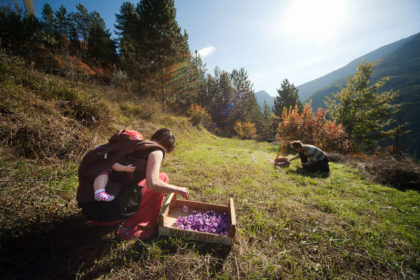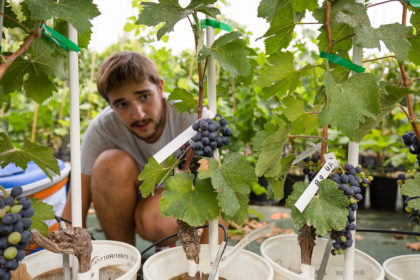Lavender is often seen as the quintessential symbol of Provence. Every July, holidaymakers flock to see fields of lavender and their rows of purple. Year-round, lavender-based creams & soaps, scents produced by the parfumeries in Grasse and tableware & linen decorated with lavender flowers make up a significant proportion of the souvenirs purchased by visitors to the South of France.
But the lavender industry is about more than just tourism. Essential oil of lavender is widely used in medicinal, cosmetic and aromatherapy products. It has properties that make it an effective natural insect repellant. Less well-known is lavender’s role in Provençal cuisine: those who haven’t come across it in their food – salads, cakes, ice cream or tea – may nonetheless have tasted lavender honey. The renowned purple flower is a desirable commodity worldwide and France produces over 50% of it. Last summer, German magazine Stern came to the South of France to write a travel feature about lavender-growing regions off the beaten track and I was asked as reportage photographer to join.
Sieste & espionage
Stern writer, Stephan, flew into Nice airport and hired the car that would be our Real Lavender Mission Vehicle. It was early afternoon and baking hot when he arrived. The South of France sieste is one tradition that I enthusiastically follow wherever possible and if Stephan was surprised to pick up a photographer who, after a brief ‘bonjour‘, promptly put the passenger seat back and fell into a deep, drooling doze, he didn’t show it.
We started our reportage in Manosque, close to what is perhaps the touristic heart of the French lavender industry. We certainly weren’t alone: hundreds arrive every day at the Occitane en Provence visitor centre. An educational garden and guided tours create plenty of opportunities to learn about lavender and the making of lavender-based and other Occitane-branded products, and even more opportunities to buy them. While Stephan apparently appreciated a break from driving to blend into the crowd and quietly follow the factory tour, I, refreshed by my siesta, energetically got into undercover photographer mode, flaunting the company’s industrial espionage rules. At the back of the group, I had managed to take a pretty nice range of photographs before I was caught out by our French madame tour guide and had the honour of a very public, loud and patronising telling-off.
Afterwards, outside the gates of the nearby Jaubert Lavender Distillery, we witnessed a rather extraordinary sight. Coaches were pulling up on the edge of the quiet country road and regurgitating dozens of (mostly Asian) tourists onto the grassy verge. Armed with cameras, sunhats and unbridled enthusiasm, they all rushed straight into the neighbouring fields of lavender to get a good look at the plants. This is apparently a daily event during the flowering season and the Jauberts have adapted to events well. A blackboard at the farm entrance advertises the menu at the snack bar they’ve opened. Instant noodles and dumplings are all listed in Chinese script, with a small English translation underneath (no French words appear at all).
Going to Die
We quickly felt we’d had our fill of the well-trodden lavender path and I, at least, was happy to get back into the car. This time, we headed away from the crowds. Northwards into the Drôme we travelled, up towards the French Alps and into the gathering dusk. Our destination was the northernmost outpost of France’s lavender growing region, centred on the little town of Die.
Die (pronounced ‘dee’) is the antithesis of busy, glossy resort towns on the Côte d’Azur. I greatly appreciated its quietness, the paint peeling from dusty-looking houses, a total absence of chain stores, minimal street lighting and the lack of signage… the next morning. However, at midnight that night, on our fifth drive around the narrow, empty and unmarked streets, trying in vain to search for our hotel, I can’t say my first impressions were positive. Although the discovery, once we had found our lodgings, that my hotel room, frozen-in-the-1950s, was still equipped with an old-though-functioning rotary dial telephone perked me up somewhat.
Next morning, after an early wander around town, now buzzing with the activities of a morning market, we set straight off to meet the lavender growers. Except that we couldn’t. Our mission vehicle had been blocked in its parking space by a little old van that looked suspiciously like it might belong to a market stallholder. Stephan sighed and held his hand on the horn for a while, but no-one appeared. Manoeuvering around the vehicle simply wasn’t possible and as I saw Stephan starting to lose his cool, I had a thought. As I suspected, the van was unlocked. A few minutes later, I found myself straining hard to push it out of the way as Stephan sat at the van’s steering wheel. It took a couple of seconds for our simultaneous realisation that it might be much more effective if he got out and pushed too, steering through the window. Soon we were off.
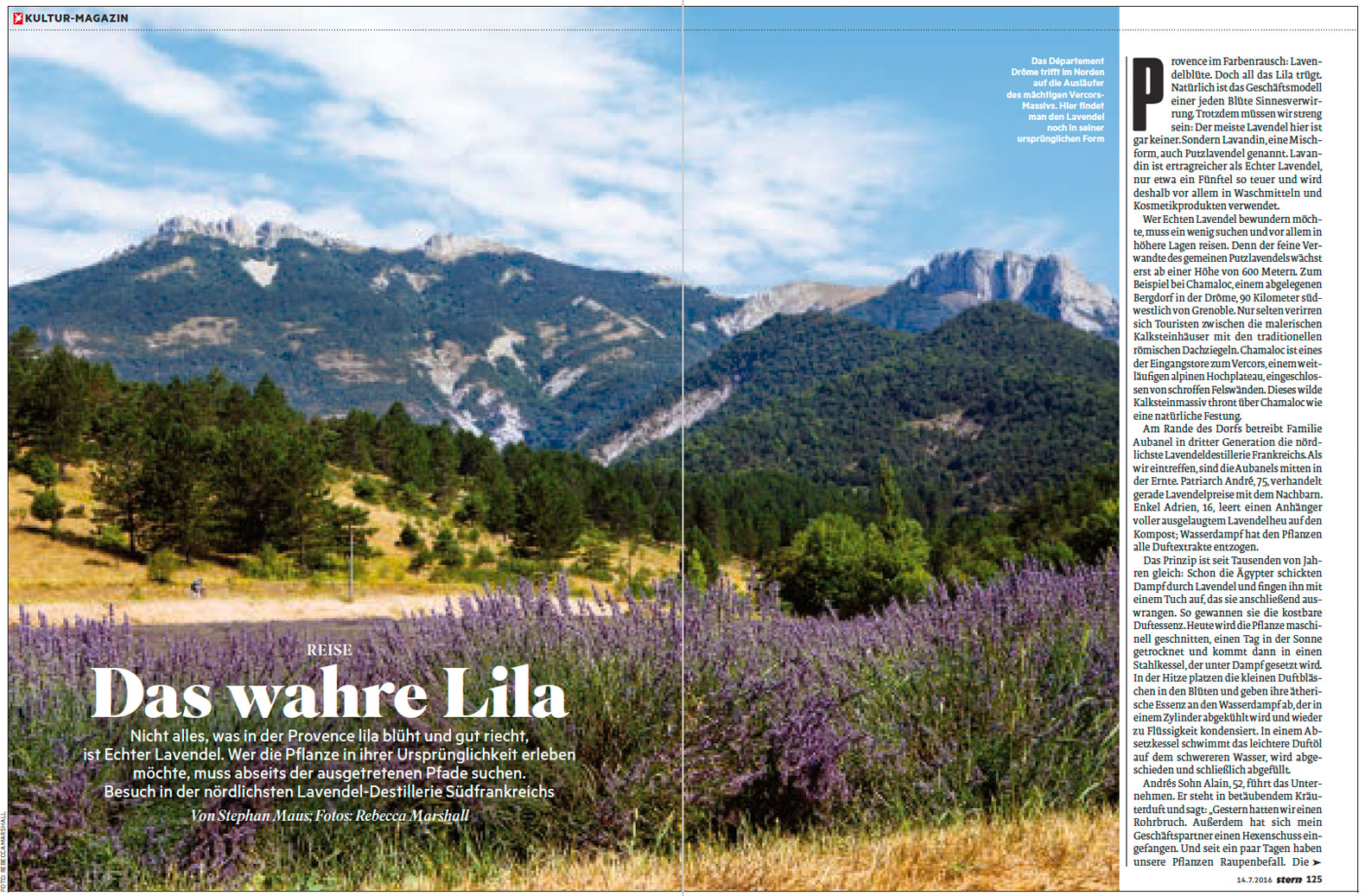
My understanding of the written article is sorely limited but the title ‘The True Purple’ seems worthy
Muddy, dusty, hot photographer
When I arrived at the Distillerie des 4 Vallons, my first stop was the hosepipe in the farmyard: I was covered in mud. From the road on the way, I had spied a beautiful field of lavender on a nearby hill. The direction of the morning sun and view meant I needed to cross the field to photograph it, and what appeared to be innocent soil between the rows of lavender turned out be to a particularly sinky, sticky sort of clay. After only a few steps, my shoes had so much mud attached that they had tripled in size and were too heavy to lift. Undeterred, I took them off and continued barefoot to get my shot. When Stephan saw the state of my feet, legs and hands on my return, he aired some mild objections about my getting back in the car, but finally agreed that he couldn’t abandon his photographer in a field so early into the job.
Here at this Aubanel family farm, the harvest and distillation of organic lavender oil was well under way, without a tourist in sight. Three generations of Aubanels and their employees were busy cutting lavender in the fields, transporting it back to the farm, crushing it, heating it and collecting its oil, then dumping the plant waste. Wives, mothers and children were sitting in the shade down the lane weaving decorative lavender objects by hand. Yet, busy as they were, everyone seemed to be in pretty good humour. Lavender, a known relaxant, was perhaps having its effect. “How does it feel to be surrounded by the overpowering scent of lavender oil all day?” I asked Alain Aubanel, as I photographed his portrait. “I feel quite high, actually,” he beamed.
When I was offered a ride in the giant ‘larvester‘, a sort of customised combine harvester, I accepted enthusiastically. However, as everyone was working round the clock, the driver clearly had no intention of stopping, nor of cutting the airoplane-level engine noise to explain to a clueless photographer how to get aboard or which moving parts to avoid. When the signal was given, I crossed my fingers, ran alongside and scrambled aboard. I was instantly grateful for the noise-cancelling earmuffs that the driver gallantly took off to give me, and worked out by trial and error which parts of the vehicle were hotter than boiling point and which others could be (uncomfortably) leaned on. I precariously wedged myself in the cab, did my best to breathe – and take photographs – through the thick clouds of hot lavender dust and started to feel strangely high myself.
Hunting for the holy lavender grail
After experiencing all stages of the lavender harvest with the Aubanels, Stephan and I then spent the rest of our assignment in and around the regional natural park of the Vercors. We checked out the local scenery, hikes, hotels, restaurants and even a war museum to provide a complete list of travel recommendations for readers who might seek something other than lavender during their vacation. Yet, as photographer, I felt that we had missed something: seeing lavender growing in the wild.
A different species of lavender from the cultivated variety, the wild version is also valued for its medicinal and culinary properties. For the reportage, I felt it was important to photograph the origin of the whole industry: lavender growing free in the hills of the Drôme. To this end, I interrogated old ladies on village benches, climbed up hills where likely lavender spots had been pointed out by wagging fingers and gazed intently at the landscape from the car window, but to no avail. I had started to give up the quest entirely by the last afternoon of our assignment, when, on a short walk below the stunning Cirque d’Archiane, I caught sight of a flash of blue next to the path. The alarm in Stephan’s eyes was testament to the volume of my shout as I knelt down and roared with delight: all across the mountain meadow alongside, in amongst the grass, bees were buzzing busily around a whole wild garden of lavender.
